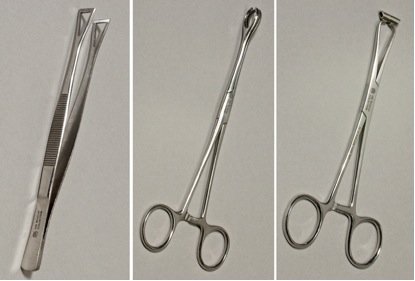Piercing tools
UK, c. 2001
 Donated by Chris Tree in 2001; 2001.64.1–.2 and .4These items were donated in 2001 by Oxford-based body piercer Chris Tree as examples of the different types of tools used in contemporary body piercing.
Donated by Chris Tree in 2001; 2001.64.1–.2 and .4These items were donated in 2001 by Oxford-based body piercer Chris Tree as examples of the different types of tools used in contemporary body piercing.
On the left is a set of 'tweezer clamps', measuring 15 cm in length. They are used for holding the skin when piercing the eyebrow, ear, nostril, lip and genitals. They are branded with the logo of the 'Wildcat' body piercing studio in Brighton. In the centre is a pair of stainless steel open-end sponge clamps, used mainly for belly button piercing. On the right is a pair of scissor-shaped stainless steel forceps, used for holding the skin when piercing the nasal septum (the cartilage wall that separates the nostrils in the nose).
Navel (belly-button) piercing is a relatively modern phenomenon, gaining popularity in the 1980s, but ancient mummies, skeletal remains, paintings, sculptures and ornamental artefacts testify to the long history more conventional piercings in the ears, lip and nose. A 5,300-year-old mummified body found in an Austrian glacier (the oldest yet discovered), had a large ear piercing. More than a thousand years later during the medieval period, European sailors often wore a single earring as the result of a superstitious belief about improved long-distance vision. In addition, if the earring was made of gold or silver, it supposedly acted as an insurance to afford a proper funeral if their body washed up ashore.
Nose piercing has been practised all over the world, from the Middle East to North Africa, from Australia to Mesoamerica for several thousand years or more. The Moghuls brought nose piercing to India in the 16th century. Among Indian women a small stud or ring is commonly worn in the left nostril since that spot, according to traditional Ayuvedra medicine, is associated with female fertility so the piercing is meant to ease the pain caused by menstruation and childbirth. Warrior tribes in Papua New Guinea and the Solomon Islands sometimes wear tusks through the septum to imitate the fierce look of the wild boar.
